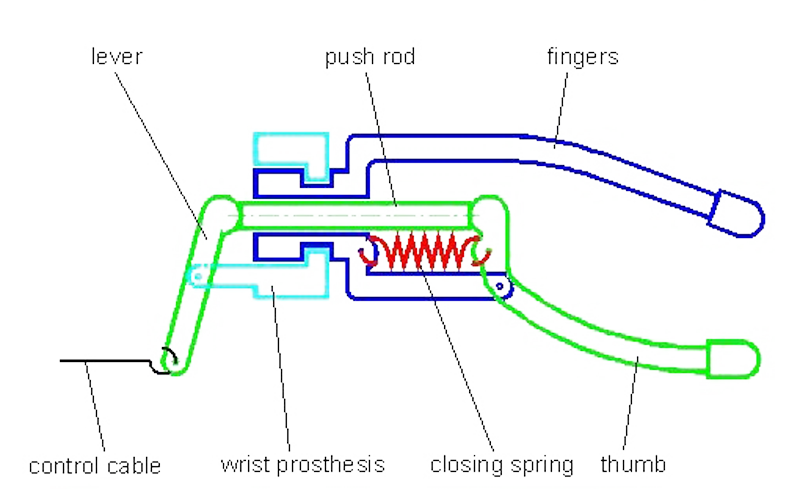WILMER Central Operated Terminal Devices
Children with a unilateral arm defect can perform many tasks very well by just using their sound arm. For more complex tasks other parts of the body can be called to aid, for instance fixing an object between the teeth, between the arm stump, or between the legs. The use of a hand or hook prosthesis increases the possibilities. Already a simple, purely cosmetic, prosthesis can be used to assist carrying large objects or to fix objects against a table surface. It also improves cosmetics. This is of utmost importance for someone with an arm defect. Performing tasks two-armed prevents overloading the sound arm. Odd movements of the trunk become obsolete by having two arms of equal length.
A functional prosthesis offers again additional possibilities, such as grasping the handle-bar of a bicycle, or fixing a zipper. The WILMER terminal devices are part of a unique prosthetic system.
Central Pushrod Operation
The system comprises a wrist prosthesis, a hand prosthesis and a hook prosthesis. Both the hand and hook prosthesis are voluntary opening devices. The control cable action is transmitted to the hand or hook by a lever located proximal to the wrist and a pushrod in the center of the wrist. This central pushrod layout offers some unique features:
- the required operating power is independent of the wrist rotation angle. Wrist rotation does not interact with the position of the control cable, as in the conventional control cable lay-out.
- the exchange of the hand for a hook is very simple as there is no need to detach the control cable.
- reduced wear of clothing, especially at the wrist. The very eccentric, small diameter inner control cable, in the traditional lay-out responsible for the dramatic wear of clothing, can be deposed of in the central pushrod lay-out.
The wrist rotator does not need a separate control action. Opening the hand or hook is automatically preceded by unlocking the wrist rotator. As desired the wrist rotation angle can be adjusted. Once an object is grasped the wrist will automatically lock again. Moreover this system offers the user an easy exchange possibility between hand and hook.
Indications
- for children with (unilateral) upper limb deficiencies at forearm or upper arm level
Characteristics
- body powered arm prosthesis system with automatically locking/unlocking wrist rotator
- to be combined with WILMER hand prosthesis and/or WILMER hook prosthesis
- provides excellent cosmetics and is insensitive to sand, water and dirt
- operating power for the connected terminal device is totally independent of the wrist rotation angle
- dramatic reduction of wear of clothing. The control cable is located inside the forearm socket
- the exchange of the hand for a hook is very simple as there is no need to detach the control cable


